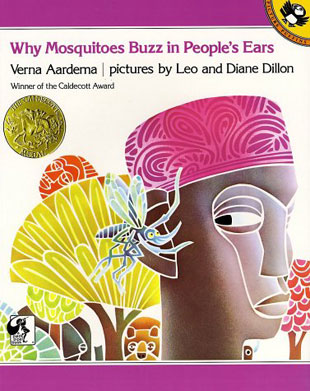
Why mosquitos buzz in peoples ears
Allfolktales.com reviews Why Mosquitoes Buzz in People's Ears: A West African Tale by Verna Aadema, illustrated by Leo and Diane Dillon.

After hearing the folktale about why
mosquitos buzz in people's ears (read
story here), I was curious to learn if the book by the same title
was based on the same or similar story. So I bought the book and I'm glad
I did because my 5 year old daughter loves it. The stories are different,
intersecting only at the end where the mosquito buzzes in someone's ears
and gets slapped (kpao!).
The book narrates the chain of events that led to the mosquitos sorry
end. The mosquito dared to compare itself to a yam which angered the iguana.
Iguana blocked his ears with a stick, not wanting to hear such nonsense.
Eventually, Mother Owl would not wake up the sun and King Lion had to
summon the Mother Owl to ask why she wouldn't wake up the sun. And after
tracing the chain of events backwards, the culprit was found - the mosquito.
As delightful as the story was, what was even more delightful were the
illustrations which were beautifully done. The colors are vivid and something
about he art makes me stop to look at the details. A note in the book
describing the art stated:
The art for this book was prepared in full color using watercolors applied with an airbrush in both fine spray and spatter technique, pastels rubbed on by hand, and india ink. The cut-out effect was achieved by actually cutting the shapes out of vellum and frisket masks at several different states.
While I only marginally understand what this means (not knowing what india ink, vellum and frisket masks are and only guessing on what's meant by the cut-out effect), I felt awed by the effort that must have gone into creating the artwork. I felt a deep appreciation of how much hard work could be involved in creating great art. It dawned on me for the first time that great art, isn't merely the result of talent. Obviously, talent and experience are required to utilize the right mix of tools and techniques, but hardwork cannot be discounted.
I looked at the illustrations through new eyes - they
truly are magnificent. It is no wonder the book won the Caldecott
award in 1976. Leo and Diane Dillon, the illustrators won a second
Caldecott award the following year for their illustrations in the book,
Ashanti to Zulu: African Traditions. That's a book I will be looking up
soon.
About | Stories | Reviews | Glossary | Links | Contact Us